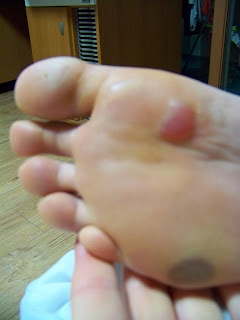Have you ever tried saying a word repeatedly until it sounds foreign? As English teachers in a foreign country, there are certain English phrases that have been drilled so pointedly that they have become cliché and at times, foreign. Every subject has a standard curriculum so it’s only natural that English would do the same. The text books we teach from bring an… unique... perspective to the list of vocabulary that is deemed necessary to learning the English language. You might be interested to learn that this is a compilation of some of the commonly used phrases (both correct and incorrect) and some of the commonly taught English phrases in Korea
.
* A:
How are you? B:
I'm fine thank you. How are you? -- My students say this greeting like automatons. They don't wait for a response. It goes like this: "
howareyoui'mfinethankyouhowareyou." Granted, students are a reflection of their learning environment. Since they have been asked to give this response at the beginning of every class since the time they were 9 (or younger), it’s only natural that they can’t understand the relevance of the question.
*
nowadays-- I had a co-teacher that used "nowadays" to express ANY event that was current. "Last year I went to the movies a lot, but
nowadays I don't have the time." "
Nowadays I like yoga better than pilates." "
Nowadays my school work keeps me very busy.”
Nowadays.
Nowadays. Nowadays. I don’t remember using this word often, but
nowadays I avoid it like the plague.
*
So so – I’ve tried desperately to eliminate this response from my students’ vocabulary when I ask them, “How are you?” I hear it so frequently that it sounds unnatural to respond, “I’m
so so.” I suppose it’s easy for them to remember.
*... a kind of.. – as in “Ja ja myung
is a kind of noodle.” I’m not sure if this is even proper English… it sounds strange to me now.
*
I know it well / I do not know it well
*
losing your weight—this is not a phrase that is taught in English text books, but every Korean I know says, “Have you been
losing your weight?” when they mean to say, “Have you been losing weight?”
*
That's too bad! Entirely over used in Korea! They don’t use it sarcastically as we do. When you tell them that your puppy died and they say, “
That’s too bad” they really do mean, “That’s too bad. I’m sorry to hear that.”
* A:
Where's ABC Bank? B:
Go straight and turn left at the corner. It’s next to the school. You can’t miss it!—I can’t give directions without saying them in a pleasant standard English accent like the one our text book CD Rom uses. It sounds like a car GPS. Again, it’s so automatonic.
*
Take a rest – As far as I know, this is not taught in textbooks, however, it is used far too often. I’ve heard some Brits and Canadians give the okay on this expression; it sounds a little unnatural to my ears to use
rest as a noun.
*
It's difficult/good/interesting/nice— As of lately, I’ve been guilty of using these general expressions because I know that nearly anyone with beginner English can understand. Obviously, Koreans use them because they are simple and they express a very broad idea. The problem: they are too broad! I had a Korea friend tell me, “
He is good.” … How is he good? You mean that he is kind? He is intelligent? He can ride a bike a tie his shoes at the same time?
*
diligent— They use it all the time, so I use it all the time. The word “diligent” is not misused, but perhaps overused, which, I think, reflects its value in Korean culture.
* I have an appointment or I made a promise… with my friend – Misused in any situation to express general plans. What they mean to say is, “I have plans.”
* He/She said to me—It might just be me, but this phrase could do without the “to me” part.
*
In my case – This one sounds weird to me now.
*
How about___? Let's ____ -- The 5
th grade curriculum has a whole chapter devoted to these two phrases. They sound a little robotic
*
I’m sorry to you/him/her—not taught, but often said incorrectly. What they mean to say is “I’m sorry that I …”
*
I’m expecting—Nope, not pregnancy. Many Koreans say “
I’m expecting…” when they mean to say “I’m excited about…”
*
I recommend to you – just take out that “to you.” Prepositions are hard! With every verb, you have to memorize, first, whether it takes a preposition or doesn’t and, second, which one! in, to, with, for, on,…,??
* “
You are boring” when they mean, “You are bored.” Or “
It was funny” when they mean, “It was fun.” It wasn't until second thought that I realized that my co-teachers were not trying to insult me when they said, "You must be boring."
*
try this
*
Style – The word style is highly overused! “That’s Korean
style.” “That’s my
style.” “He’s my
style.” “Those shoes are my
style.” “That shirt is American
style.”
Again, just a little light hearted fun. I can't say half of these expressions without a smile on my face. Unfortunately, I've adopted many of these expressions because I know that A) Koreans know them and will, therefore, understand what I'm saying and B) I hear them so frequently that I can't help but saying them. Either way, they've taken on a new identity-- a Korean identity. It's a funny sensation to say certain phrases in my native tongue and all the while be thinking, "this sounds mighty foreign."
 1. When it is raining but the sun is out:
1. When it is raining but the sun is out:












